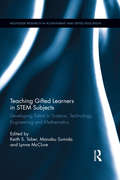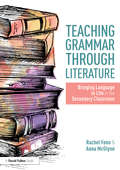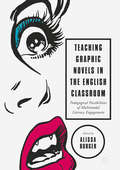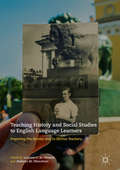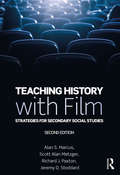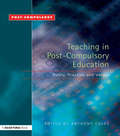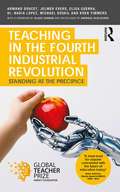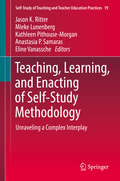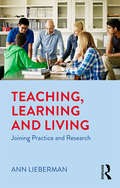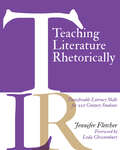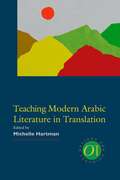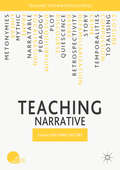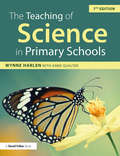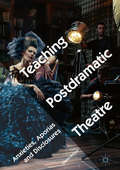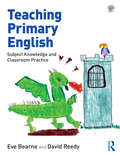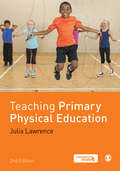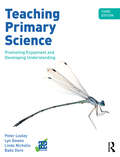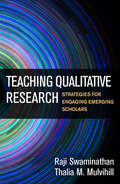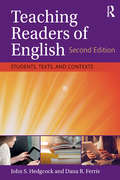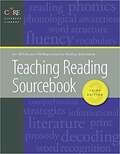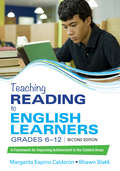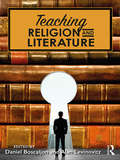- Table View
- List View
Teaching Gifted Learners in STEM Subjects: Developing Talent in Science, Technology, Engineering and Mathematics (Routledge Research in Achievement and Gifted Education)
by Keith S. Taber Manabu Sumida Lynne McClureThis book offers an overview of programmes designed to support the learning of gifted and talented students in STEM subjects, both to allow them to meet their potential and to encourage them to proceed towards careers in STEM areas. The chapters from a range of national contexts report on perspectives, approaches and projects in gifted education in STEM subjects. These contributions provide a picture of the state of research and practice in this area, both to inform further research and development, and to support classroom teachers in their day-to-day work. Chapters have been written with practitioners in mind, but include relevant scholarly citations to the literature. The book includes some contributions illustrating research and practice in specific STEM areas, and others which bridge across different STEM subjects. The volume also includes an introductory theoretical chapter exploring the implications for gifted learners of how 'STEM' is understood and organized within the school curriculums.
Teaching Grammar through Literature: Bringing Language to Life in the Secondary Classroom
by Anna McGlynn Rachel FennThis essential guide offers a fresh approach to integrating grammar effectively into the classroom as a vital strand of English that both enlivens and enriches students’ understanding of literature. It aims to demystify grammar and empower teachers with the knowledge, inspiration and practical ideas to confidently teach grammar to students at any stage of their secondary education. The authors demonstrate that routinely weaving grammar into lessons and the study of literature, rather than teaching it as an abstract set of rules, enables students to see grammar in a more flexible, enjoyable and exciting way. Each chapter clearly defines complex terminology and provides an essential overview of relevant subject knowledge. With multiple examples of textual analysis and a variety of adaptable lesson plans for popular Key Stage 3 and Key Stage 4 texts, the book shows how grammatical requirements can be taught in a lively, literature-based manner, developing students’ understanding and improving the quality of their creative and academic writing. Taught like this, grammar becomes a decoding tool: a key to unlocking deeper meaning within texts that enriches the reading experience. Considering a wide range of texts, Teaching Grammar through Literature thoroughly works through core grammatical concepts such as: sentences and sentence clauses nouns verbs determiners punctuation extension vocabulary. This book is a source of fresh and exciting ideas for all practising secondary school English teachers. It will revolutionalise teaching and enrich students' understanding of literature and the grammatical theory within.
Teaching Graphic Novels in the English Classroom
by Alissa BurgerThis collection highlights the diverse ways comics and graphic novels are used in English and literature classrooms, whether to develop critical thinking or writing skills, paired with a more traditional text, or as literature in their own right. From fictional stories to non-fiction works such as biography/memoir, history, or critical textbooks, graphic narratives provide students a new way to look at the course material and the world around them. Graphic novels have been widely and successfully incorporated into composition and creative writing classes, introductory literature surveys, and upper-level literature seminars, and present unique opportunities for engaging students' multiple literacies and critical thinking skills, as well as providing a way to connect to the terminology and theoretical framework of the larger disciplines of rhetoric, writing, and literature.
Teaching History and Social Studies to English Language Learners
by Luciana C. de Oliveira Kathryn M. ObenchainThis book investigates the preparation of secondary history and social studies (SS) teachers to teach English language learners (ELLs) in twenty-first century classrooms. This edited collection focuses on the ways in which pre-service and in-service teachers have developed - or may develop - instructional effectiveness for working with ELLs in the secondary history and social studies classroom. The authors address a variety of standards and content examples, including the National Council for Social Studies C3 Framework and Curriculum Standards, the Common Core State Standards for English Language Arts, and content from history, geography, and civics. This volume is part of a set of four edited books focused on teaching the key content areas to English language learners.
Teaching History with Film: Strategies for Secondary Social Studies (Contemporary Research In Education Ser.)
by Alan S. Marcus Scott Alan Metzger Richard J. Paxton Jeremy D. StoddardTeaching History with Film provides a fresh, engaging, and clear overview of teaching with film to effectively enhance social studies instruction. Using cases of experienced teachers to illustrate accomplished history teaching through movies, this text provides pre- and in-service teachers with ideas for implementing film-based lessons in their own classrooms and offers a deeper understanding of the thorny issues involved in using film to teach history. The second edition is completely revised and updated including: two entirely new case studies; a new chapter focusing on using international film and incorporating a more global view in the classroom; and additional material on using film to tackle difficult and controversial issues; as well as updates to all of the cases. Each section of the book focuses on how teachers can effectively support the development of students’ historical film literacy through topics such as using film to develop interpretive skills, to explore controversial issues, and to develop historical empathy. By developing the skills students need to think critically about the past or what they think they know about history, the lessons in this book illustrate how to harness the pedagogical power of film to provide the tools necessary for rigorous inquiry and democratic citizenship. Special features include: "Reflection on the Case," following each chapter, analyzing and discussing the strengths and limitations of the teacher’s approach as well as providing strategies for using and choosing films specific to the educational outcome Sample unit outlines, descriptions of class texts and films, worksheets, essay questions, viewer guides, and exercises for the classroom throughout Discussion of the practical considerations facing classroom teachers, including juggling time restraints, issues of parental permission, and meeting standards
Teaching in Post-Compulsory Education: Policy, Practice and Values
by Anthony Coles Karen McGrathWith an emphasis on developing higher-order learning skills, such as reflection, critical evaluation and action research, this book provides a comprehensive guide to contemporary and contextual issues within post-compulsory education. This book: * Helps students fulfill Qualified Teacher in Further Education (QTFE) criteria * Provides information and advice on provision for the 14-19 sector * Is structured specifically around the FENTO values * Includes mind-maps charting links to FENTO standards * Provides help with assignments through reflective questions and discussion points
Teaching in the Fourth Industrial Revolution: Standing at the Precipice
by Jelmer Evers Armand Doucet Elisa Guerra Dr Nadia Lopez Michael Soskil Koen TimmersIn this visionary book, written by six internationally recognized Global Teacher Prize finalists, the authors create a positive and hope-filled template for the future of education. They address the hard moral, ethical and pedagogical questions facing education today so that progress can serve society, rather than destroying it from within our classrooms. This blueprint for education finally brings forward what has always been missing in education reform: a strong collective narrative with authentic examples from teachers on the front line. It is a holistic, personalized approach to education that harnesses the disruptions of the Fourth Industrial Revolution to better shape the future for the next generation, and ensure that every child can benefit from the ongoing transformations. A great read for anyone who has an interest in educating our youth for these uncertain times, highlighting why teachers will always matter.
Teaching Laboring-Class British Literature of the Eighteenth and Nineteenth Centuries (Options for Teaching #43)
by Kevin Binfield William J. ChristmasBehind our contemporary experience of globalization, precarity, and consumerism lies a history of colonization, increasing literacy, transnational trade in goods and labor, and industrialization. Teaching British laboring-class literature of the eighteenth and nineteenth centuries means exploring ideas of class, status, and labor in relation to the historical developments that inform our lives as workers and members of society. This volume demonstrates pedagogical techniques and provides resources for students and teachers on autobiographies, broadside ballads, Chartism and other political movements, georgics, labor studies, satire, service learning, writing by laboring-class women, and writing by laboring people of African descent.
Teaching, Learning, and Enacting of Self-Study Methodology: Unraveling A Complex Interplay (Self-study Of Teaching And Teacher Education Practices Ser. #19)
by Jason K. Ritter Mieke Lunenberg Kathleen Pithouse-Morgan Anastasia P. Samaras Eline VanasscheThis book offers a collection of original, peer-reviewed studies by scholars working to develop a knowledge base of teaching and facilitating self-study research methodology. Further, it details and interconnects perspectives and experiences of new self-study researchers and their facilitators, in self-study communities in different countries and across different continents. Offering a broad range of perspectives and contexts, it opens up possibilities for encouraging the collaborative and continuous growth of teaching and facilitating self-study research within and beyond the field of teacher education. The breadth of the scholarship presented expands scholarly discussions concerning designing, representing, and theorising self-study research in response to pressing educational and social questions. By documenting and understanding what teaching and learning self-study looks like in different contexts and what factors might influence its enactment, the book contributes to building a kaleidoscopic knowledge base of self-study research. Overall, this book demonstrates the impact on participants' professional learning and validates the authenticity and generative professional applications of self-study methodology for and beyond teacher education, providing implications and recommendations for practitioners on a global level.
Teaching, Learning and Living: Joining Practice and Research
by Ann LiebermanBy tracing the development of Ann Lieberman’s commitment to exploring the complex, entwined nature of teaching, learning and living, this book reflects on how research in teacher leadership and development has progressed and changed over the last fifty years. This personal account highlights Lieberman’s learning as she engaged in research to build collaborative ways of working. Portraying the fight for teacher participation in research studies about teaching, schooling and teacher improvement so that the complexity of their lives would be represented, and writing about the consideration of teacher’s work in any efforts for school improvement, the book discusses the initial collaboration between researchers and teachers. It then proceeds to outline a number of research projects that document the changing relationship of research and teaching and offers guidance on some of the most important and successful programs and strategies in the field. It questions issues such as how to create a culture in the school that is supportive of teachers, and how research can best assist teachers to improve their work. Teaching, Learning and Living is a personal, historical and professional look at the growth in knowledge that began to change the views of research and teaching and is a must-read for anyone interested in the development of teacher education.
Teaching Literature Rhetorically: Transferable Literacy Skills for 21st Century Students
by Jennifer FletcherEnglish language arts teachers often find themselves defending their discipline and the practical values it has. When will I read this again? is an all too common question heard in classrooms. Author Jennifer Fletcher faced the same questions and more. In Teaching Literature Rhetorically: Transferable Literacy Skills for 21st Century Students she shows you how to help your students develop transferable literacy skills that allow them to succeed not just in their English language arts classes, but in their future lives and careers. The book is built around eight high-utility literacy skills and practices that will help students communicate effectively and with confidence as they navigate important transitions in their lives: Integrating skills and knowledge from texts Reading closely and critically Assessing rhetorical situations Negotiating different perspectives Developing and supporting a line of reasoning Analyzing genres Communicating with self and others in mind Reading and writing with passion Teaching Literature Rhetorically offers readers writing prompts, readings, discussion questions, graphic organizers, as well as examples of student work and activities for helping students to understand key rhetorical concepts. As Fletcher writes in her introduction rhetorical thinking promotes the transfer of learning — the single most important goal we can have as teachers if we hope to have a positive impact on our students&’ lives. This book will help teachers everywhere do just that.
Teaching Modern Arabic Literature in Translation (Options for Teaching #42)
by Michelle HartmanUnderstanding the complexities of Arab politics, history, and culture has never been more important for North American readers. Yet even as Arabic literature is increasingly being translated into English, the modern Arabic literary tradition is still often treated as other--controversial, dangerous, difficult, esoteric, or exotic. This volume examines modern Arabic literature in context and introduces creative teaching methods that reveal the literature's richness, relevance, and power to anglophone students.Addressing the complications of translation head on, the volume interweaves such important issues such as gender, the Palestinian-Israeli conflict, and the status of Arabic literature in world literature. Essays cover writers from the recent past, like Emile Habiby and Tayeb Salih; contemporary Palestinian, Egyptian, and Syrian literatures; and the literature of the nineteenth-century Nahda.
Teaching Narrative (Teaching The New English Ser.)
by Richard JacobsNarrative is everywhere and has unique powers: to enchant and inspire, to make sense of our lives and ourselves and to afford us an enriched understanding of alternative worlds and lives and of better futures – though narrative also has the potential to coerce and oppress. Narrative is at the centre at all stages of the English curriculum and has been the subject of a burgeoning critical industry. This timely volume addresses the many ways in which recent thinking has informed the teaching of narrative in university classrooms in the UK and the USA. Distinguished teachers from both countries range widely across narrative topics and genres, including the opportunities opened up by new technologies, and chapters articulate students’ own individual and collaborative experiences in the teaching/learning process. The result is a volume that explores the pleasurable challenges of working with students to help them appreciate and assess the power that narrative exerts, to become reflective critics of its inner workings as well as exponents of narrative themselves.
The Teaching of Science in Primary Schools
by Wynne Harlen ObeNow in a fully updated seventh edition, The Teaching of Science in Primary Schools provides essential information for students, trainee, and practising teachers about the why, what and how of teaching primary science. Paying particular attention to inquiry-based teaching and learning, the book recognises the challenges of teaching science, and provides suggestions and examples aimed to increase teachers’ confidence and pupils‘ enjoyment of the subject. This new edition explores: Changes in curriculum and assessment requirements in the UK Advances in knowledge of how children learn Expansion in the use of ICT by teachers and children And expands on key aspects of teaching including: The compelling reasons for starting science in the primary school Strategies for helping children to develop understanding, skills and enjoyment Attention to school and teacher self-evaluation as a means of improving provision for children’s learning. Giving the latest information about the rationale for and use of inquiry-based, constructivist methodology, and the use of assessment to help learning, the book combines practice and theory, explaining and advocating for particular classroom interactions and activities. This book is essential reading for all primary school teachers and those engaged in studying primary education.
Teaching Postdramatic Theatre: Anxieties, Aporias and Disclosures
by Glenn D’CruzThis book explores the concept and vocabulary of postdramatic theatre from a pedagogical perspective. It identifies some of the major anxieties and paradoxes generated by teaching postdramatic theatre through practice, with reference to the aesthetic, cultural and institutional pressures that shape teaching practices. It also presents a series of case studies that identify the pedagogical fault lines that expose the power-relations inherent in teaching (with a focus on the higher education sector as opposed to actor training institutions). It uses auto-ethnography, performance analysis and critical theory to assist university teachers involved in directing theatre productions to deepen their understanding of the concept of postdramatic theatre.
Teaching Primary English: Subject Knowledge and Classroom Practice
by Eve Bearne David ReedyTeaching Primary English is a comprehensive, evidence-informed introduction designed to support and inspire teaching and learning in the primary school. Written in a clear and accessible way, it draws on the very latest research and theory to describe and exemplify a full and rich English curriculum. It offers those on teacher training courses, as well as qualified teachers who are looking to develop their practice, subject knowledge and guidance for effective, enjoyable classroom practice. Advice and ideas are supported by explicit examples of good teaching linked to video clips filmed in real schools, reflective activities, observational tasks and online resources. Each chapter includes suggestions for great children’s literature, considers assessment throughout and offers support planning for diversity and special educational needs. Key topics covered include: spoken language for teaching and learning storytelling, drama and role play reading for pleasure early reading, including phonics poetry writing composition spelling and handwriting grammar and punctuation responding to and assessing writing multimodal, multimedia and digital texts. With a focus on connecting all modes of English, the global and the local, and home and school experience, this detailed, uplifting book will support you in developing a curious, critical approach to teaching and learning English. Additional content can be found on the fantastic supporting website. Features include: video clips from within the classroom to demonstrate English teaching techniques audio resources, including an interactive quiz, to check understanding and provide real-life examples and case studies downloadable resources to support teaching and incorporate into lesson plans.
Teaching Primary Physical Education
by Julia LawrencePhysical education is an important part of the primary curriculum and one that provides unique challenges for those involved with its teaching. This book offers a balanced and comprehensive overview of the subject, covering issues such as safe practice in PE, inclusion, subject leadership and cross-curricular approaches supported by an accessible theory-informed approach. This second edition includes: · Links to the new National Curriculum in England · Each chapter mapped against the Teachers’ Standards · A new chapter on physical literacy and development in the early years and primary ages · A new chapter on health-focused education and the contribution of PE · Added case studies in every chapter · Enhanced coverage of assessment in PE This book includes a companion website with additional resources!
Teaching Primary Physical Education
by Julia LawrencePhysical education is an important part of the primary curriculum and one that provides unique challenges for those involved with its teaching. This book offers a balanced and comprehensive overview of the subject, covering issues such as safe practice in PE, inclusion, subject leadership and cross-curricular approaches supported by an accessible theory-informed approach. This second edition includes: · Links to the new National Curriculum in England · Each chapter mapped against the Teachers’ Standards · A new chapter on physical literacy and development in the early years and primary ages · A new chapter on health-focused education and the contribution of PE · Added case studies in every chapter · Enhanced coverage of assessment in PE This book includes a companion website with additional resources!
Teaching Primary Science: Promoting Enjoyment and Developing Understanding
by Peter Loxley Lyn Dawes Linda Nicholls Babs DoreThis fully updated third edition brings science subject knowledge and pedagogy together to support, inform and inspire those training to teach primary science. Written in a clear and accessible way, Teaching Primary Science provides comprehensive coverage of a wide range of science themes. With a brand new chapter on STEM education, additional guidance on where to find the best resources, and increased emphasis on assessment, story-telling and problem-solving, this book shows how science can offer children pleasure and intellectual satisfaction and help them to develop sound scientific minds. Key features include: Ideas for practice exemplify how you can help children to acquire and use scientific knowledge to satisfy their curiosity about how the natural world works. Something to think about scenarios help to extend and develop your own understanding of key ideas. Examples of classroom situations, dialogues and stories help you see how theory is applied to practice and support you in reflecting on the best methods for teaching. Global Dimension sections offer starting points for discussion and research into how scientific ideas can be positively applied and used to evaluate the impact of human activity on the natural world. Talk Skills and Science Discussion sections enable you to develop children’s scientific knowledge and verbal reasoning skills.
Teaching Qualitative Research: Strategies for Engaging Emerging Scholars
by Raji Swaminathan Thalia M. MulvihillThis timely resource provides a framework for teaching students how to think qualitatively and become more critical and reflexive researchers. Presented are a wealth of pedagogical tools that instructors across the disciplines can tailor to their own needs, including thought-provoking discussion questions, group work exercises, and field activities. The authors discuss issues and choices in course design, including approaches to assessment and grading, and share sample syllabi for both online and face-to-face course formats. Exploring the complexities and debates that surround teaching qualitative research, the book argues for a holistic model of preparing novice researchers. It demonstrates effective ways to engage students in the qualitative inquiry process from start to finish--from understanding positionality and crafting a research problem to writing up findings for different audiences.
Teaching Readers of English: Students, Texts, and Contexts
by John S. Hedgcock Dana R. FerrisA comprehensive manual for pre- and in-service ESL, EFL, and EIL educators who work with multilingual students at the secondary and postsecondary levels, this text balances insights from reading theory and research with highly practical, field-tested strategies for teaching and assessing second-language reading that educators can readily adopt and adapt to suit their contexts and student populations. Teaching Readers of English is a complete "go-to" source for teaching reading and promoting classroom and professional literacies in an increasingly digital world. Offering principled approaches and methods for planning and delivering effective L2 reading instruction, the text includes pedagogical features, such as questions for reflection, further reading and resources, and application activities to develop purposeful classroom reading lessons in a range of contexts. Changes in the Second Edition: Updated and revised chapters on formative and summative reading assessment, developing vocabulary knowledge and grammatical skill, and cultivating extensive reading and literary appreciation Updated information on institutional settings and reader demographics New pedagogical features in each chapter, including Chapter Summaries, Further Reading, Reflection and Review, and Application Activities A streamlined chapter sequence to enhance the text’s usability
Teaching Reading Sourcebook
by Bill Honig Linda Diamond Linda Gutlohn Carrie L. Cole Pamela Beard El-Dinary Roxanne F. Hudson Holly B. Lane Jacalyn Mahler Paige C. PullenThe CORE Literacy Training Series gives teachers in grades K-8 the tools they need to become skillful reading teachers. The three titles in the series provide (1) thorough background and effective teaching methods, (2) a comprehensive classroom assessment system, and (3) a compilation of the research on which effective reading instruction is based.
Teaching Reading to English Learners, Grades 6 - 12: A Framework for Improving Achievement in the Content Areas
by Margarita Espino Calderon Shawn SlakkRetool your whole school for EL achievement For any student, middle and high school can be challenging. But for an English learner or striving reader—and the myriad words, phrases, syntax, texts, and concepts they must negotiate on a daily basis—the stakes seem a whole lot higher. Fortunately for content-area teachers, Margarita Calderón and Shawn Slakk make available in a single resource all the best instructional and professional development combinations for expediting comprehension across the secondary grades. Really a tool to assist all learners across all language needs, the second edition of Teaching Reading to English Learners, Grades 6-12, provides evidence-based strategies for helping content-area teachers and schools at large: Teach academic language in all subject areas Embed discourse practice through interaction strategies Integrate basic and close reading comprehension skills into lessons Teach drafting, revising, and editing for content-specific writing Use cooperative learning to develop social emotional skills and enhance academic achievement Calderón and Slakk know firsthand that if we’re to counter the commonly held narrative of predictable failure among our ELs, it takes a whole school, and they have the evidence to prove it. Read Teaching Reading to English Learners, Grades 6-12, implement its strategies across all classrooms, and soon enough you, too, will maximize the comprehensions skills so critical to our ELs’ long-term success.
Teaching Reading to English Learners, Grades 6 - 12: A Framework for Improving Achievement in the Content Areas
by Margarita Espino Calderon Shawn SlakkRetool your whole school for EL achievement For any student, middle and high school can be challenging. But for an English learner or striving reader—and the myriad words, phrases, syntax, texts, and concepts they must negotiate on a daily basis—the stakes seem a whole lot higher. Fortunately for content-area teachers, Margarita Calderón and Shawn Slakk make available in a single resource all the best instructional and professional development combinations for expediting comprehension across the secondary grades. Really a tool to assist all learners across all language needs, the second edition of Teaching Reading to English Learners, Grades 6-12, provides evidence-based strategies for helping content-area teachers and schools at large: Teach academic language in all subject areas Embed discourse practice through interaction strategies Integrate basic and close reading comprehension skills into lessons Teach drafting, revising, and editing for content-specific writing Use cooperative learning to develop social emotional skills and enhance academic achievement Calderón and Slakk know firsthand that if we’re to counter the commonly held narrative of predictable failure among our ELs, it takes a whole school, and they have the evidence to prove it. Read Teaching Reading to English Learners, Grades 6-12, implement its strategies across all classrooms, and soon enough you, too, will maximize the comprehensions skills so critical to our ELs’ long-term success.
Teaching Religion and Literature
by Daniel Boscaljon Alan LevinovitzTeaching Religion and Literature provides a practical engagement with the pedagogical possibilities of teaching religion courses using literature, teaching literature classes using religion, and teaching Religion and Literature as a discipline. Featuring chapters written by award winning teachers from a variety of institutional settings, the book gives anyone interested in providing interdisciplinary education a set of questions, resources, and tools that will deepen a classroom’s engagement with the field. Chapters are grounded in specific texts and religious questions but are oriented toward engaging general pedagogical issues that allow each chapter to improve any instructor’s engagement with interdisciplinary education. The book offers resources to instructors new to teaching Religion and Literature and provides definitions of what the field means from senior scholars in the field. Featuring a wide range of religious traditions, genres, and approaches, the book also provides an innovative glimpse at emerging possibilities for the sub-discipline.
